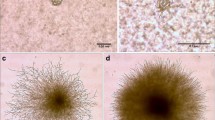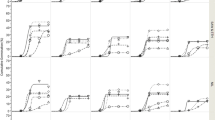Abstract
Under laboratory conditions, spores of ectomycorrhizal fungi usually germinate very poorly or not at all. In a previous study, we showed that spores of the ectomycorrhizal fungus Suillus bovinus germinated through the combination of activated charcoal treatment of media and co-culture with seedlings of Pinus densiflora, which suggested that some substances contained in root exudates induced the germination. Among the compounds reported from root exudates, flavonoids have been elucidated to play various and substantial roles in plant–microbe interactions; we therefore investigated the effects of flavonoids on basidiospore germination of S. bovinus by the diffusion gradient assay on water agar plates pretreated with charcoal powder. Seven out of the 11 flavonoids tested, hesperidin, morin, rutin, quercitrin, naringenin, genistein, and chrysin, had greater effects than controls, whereas flavone, biochanin A, luteolin, and quercetin showed no positive effects. The effective concentration presumably corresponded to several micromolar levels, which was equivalent to those effective for pollen development, nod gene induction, and spore germination of F. solani f. sp. pisi and AM fungi. The results suggest that flavonoids play a role as signaling molecules in symbiotic relationships between woody plants and ectomycorrhizal fungi.



Similar content being viewed by others
References
Aguilar JMM, Ashby AM, Richards AJM, Loake, GJ, Watson MD, Shaw CH (1988) Chemotaxis of Rhizobium leguminosarum biovar phaseoli towards flavonoid inducers of the symbiotic nodulation genes. J Gen Microbiol 134:2741–2746
Ali NA, Jackson RM (1988) Effects of plant roots and their exudates on germination of spores of ectomycorrhizal fungi. Trans Br Mycol Soc 91:253–260
Armitage JP, Gallagher A, Johnson AWB (1988) Comparison of the chemotactic behaviour of Rhizobium leguminosarum with and without the nodulation plasmid. Mol Microbiol 2:743–748
Barbour WM, Hattermann DR, Stacey G (1991) Chemotaxis of Bradyrhizobium japonicum to soybean exudates. Appl Environ Microbiol 57:2635–2639
Bauer WD, Caetano-Anollés G (1990) Chemotaxis, induced gene expression and competitiveness in the rhizosphere. Plant Soil 129:45–52
Bergemann SE, Miller SL (2002) Size, distribution, and persistence of genets in local populations of the late-stage ectomycorrhizal basidiomycete, Russula brevipes. New Phytol 156:313–320
Birraux D, Fries N (1981) Germination of Thelephora terrestris basidiospores. Can J Bot 59:2062–2064
Bjurman J (1984) An organic acid, inhibitory to spore germination of mycorrhizal fungi, formed from agar during autoclaving. Microbios 39:109–116
Bjurman J, Fries N (1984) Purification and properties of the germination-inducing factor in the ectomycorrhizal fungus Leccinum aurantiacum (Boletaceae). Physiol Plant 62:465–471
Bowen GD, Theodorou C (1973) Growth of ectomycorrhizal fungi around seeds and roots. In: Marx GC, Kozlowski TT (eds) Ectomycorrhizae: their ecology and physiology. Academic, New York, USA, pp 107–150
Brencic A, Winans SC (2005) Detection of and response to signals involved in host–microbe interactions by plant-associated bacteria. Microbiol Mol Biol Rev 69:155–194
Burg D, Guillaume J, Tailliez R (1982) Chemotaxis by Rhizobium meliloti. Arch Microbiol 133:162–163
Caetano-Anollés G, Crist-Estes DK, Bauer WD (1988) Chemotaxis of Rhizobium meliloti to the plant flavone luteolin requires functional nodulation genes. J Bacteriol 170:3164–3169
Carlile MJ (1983) Motility, taxis, and tropism in Phytophthora. In: Erwin DC, Bartnicki-Garcia S, Tsao PH (eds) Phytophthora—its biology, taxonomy, ecology and pathology. APS, St. Paul, USA, pp 95–107
Cooper JE (2004) Multiple responses of rhizobia to flavonoids during legume root infection. Adv Bot Res 41:1–62
Dharmatilake AJ, Bauer WD (1992) Chemotaxis or Rhizobium meliloti towards nodulation gene inducer compounds from alfalfa roots. Appl Environ Microbiol 58:1153–1158
Fiore-Donno A-M, Martin F (2001) Populations of ectomycorrhizal Laccaria amethystina and Xerocomos spp. show contrasting colonization patterns in a mixed forest. New Phytol 152:533–542
Fries N (1976) Spore germination in Boletus induced by amino acids. Proc K Ned Akad Wet Ser C 79:142–146
Fries N (1978) Basidiospore germination in some mycorrhiza-forming hymenomycetes. Trans Br Mycol Soc 70:319–324
Fries N (1983a) Spore germination, homing reaction, and intersterility groups in Laccaria laccata (Agaricales). Mycologia 75:221–227
Fries N (1983b) Basidiospore germination in species of Boletaceae. Mycotaxon 18:345–354
Fries N (1984) Spore germination in the higher Basidiomycetes. Proc Indian Acad Sci Plant Sci 93:205–222
Fries N (1987) Ecological and evolutionary aspects of spore germination in the higher basidiomycetes. Trans Br Mycol Soc 88:1–7
Fries N (1988) Specific effects of diterpene resin acids on spore germination of ectomycorrhizal basidiomycetes. Experientia 44:1027–1030
Fries N (1989) The influence of tree roots on spore germination of ectomycorrhizal fungi. Agric Ecosyst Environ 28:139–144
Fries N, Birraux D (1980) Spore germination in Hebeloma stimulated by living plant roots. Experientia 36:1056–1057
Fries N, Swedjemark G (1986) Specific effects of tree roots on spore germination in the ectomycorrhizal fungus, Hebeloma mesophaeum (Agaricales). In: Gianninazzi-Pearson V, Gianninazzi S (eds) Physiological and genetical aspects of mycorrhizae. INRA, Paris, France, pp 725–730
Fries N, Serck-Hanssen K, Dimberg LH, Theander O (1987) Abietic acid, an activator of basidiospore germination in ectomycorrhizal species of the genus Suillus (Boletaceae). Exp Mycol 11:360–363
Gherbi H, Delaruelle C, Selosse M-A, Martin F (1999) High genetic diversity in a population of the ectomycorrhizal basidiomycete Laccaria amethystina in a 150-year-old beech forest. Mol Ecol 8:2003–2013
Gianinazzi-Pearson V, Branzanti B, Gianinazzi S (1989) In vitro enhancement of spore germination and early hyphal growth of a vesicular–arbuscular mycorrhizal fungus by host root exudates and plant flavonoids. Symbiosis 7:243–255
Gould KS, Lister C (2005) Flavonoid functions in plants. In: Andersen ØM, Markham KR (eds) Flavonoids—chemistry, biochemistry and applications. Taylor & Francis, Boca Raton, USA, pp 397–441
Gryta H, Debaud J-C, Effosse A, Gay G, Marmeisse R (1997) Fine-scale structure of populations of the ectomycorrhizal fungus Hebeloma cylindrosporum in coastal sand dune forest ecosystems. Mol Ecol 6:353–364
Hartwig UA, Joseph CM, Phillips DA (1991) Flavonoids released naturally from alfalfa seeds enhance growth rate of Rhizobium meliloti. Plant Physiol 95:797–803
Horio T, Kawabata Y, Takayama T, Tahara S, Kawabata J, Fukushi Y, Nishimura H, Mizutani J (1992) A potent attractant of zoospores of Aphanomyces cochlioides isolated from its host, Spinacia oleracea. Experientia 48:410–414
Huai W-X, Guo L-D, He W (2003) Genetic diversity of an ectomycorrhizal fungus Tricholoma terreum in a Larix principis-rupprechtii stand assessed using random amplified polymorphic DNA. Mycorrhiza 13:265–270
Iwase K (1992) Induction of basidiospore germination by gluconic acid in the ectomycorrhizal fungus Tricholoma robustum. Can J Bot 70:1234–1238
Kape R, Parniske M, Werner D (1991) Chemotaxis and nod gene activity of Bradyrhizobium japonicum in response to hydroxycinnamic acids and isoflavonoids. Appl Environ Microbiol 57:316–319
Kikuchi K, Matsushita N, Suzuki K (2006) Germination of Suillus bovinus spores in vitro. Nippon Kingakukai Kaiho 47:37–40 (in Japanese with summary in English)
Kope HH, Fortin JA (1990) Germination and comparative morphology of basidiospores of Pisolithus arhizus. Mycologia 82:350–357
Lagrange H, Jay-Allgmand C, Lapeyrie F (2001) Rutin, the phenolglycoside from eucalyptus root exudates, stimulates Pisolithus hyphal growth at picomolar concentrations. New Phytol 149:349–355
Liang Y, Guo L, Ma K (2005) Population genetic structure of an ectomycorrhizal fungus Amanita manginiana in a subtropical forest over two years. Mycorrhiza 15:137–142
Melin E (1962) Physiological aspects of mycorrhizae of forest trees. In: Kozlowski TT (ed) Tree growth. Ronald Press, New York, USA, pp 247–263
Miller SL, Torres P, McClean TM (1993) Basidiospore viability and germination in ectomycorrhizal and saprotrophic basidiomycetes. Mycol Res 97:141–149
Mo Y, Nagel C, Taylor LP (1992) Biochemical complementation of chalcone synthase mutants defines a role for flavonoids in functional pollen. Proc Natl Acad Sci U S A 89:7213–7217
Morris PF, Ward EWB (1992) Chemoattraction of zoospores of the soybean pathogen, Phytophthora sojae, by isoflavones. Physiol Mol Plant Pathol 40:17–22
Nagahashi G, Douds DD Jr (1999) Rapid and sensitive bioassay to study signals between root exudates and arbuscular mycorrhizal fungi. Biotechnol Tech 13:893–897
Ohta A (1986) Basidiospore germination of Tricholoma matsutake (I). Effects of organic acids on swelling and germination of the basidiospores. Trans Mycol Soc Jpn 27:167–173
Ohta A (1988) Effects of butyric acid and related compounds on basidiospore germination of some ectomycorrhizal fungi. Trans Mycol Soc Jpn 29:375–381
Oort AJP (1974) Activation of spore germination in Lactarius species by volatile compounds of Ceratocystis fagacearum. Proc K Ned Akad Wet Ser C 77:301–307
Parke D, Rivelli M, Ornston LN (1985) Chemotaxis to aromatic and hydroaromatic acids: comparison of Bradyrhizobium japonicum and Rhizobium trifolii. J Bacteriol 163:417–422
Peck MC, Fisher RF, Long SR (2006) Diverse flavonoids stimulate NodD1 binding to nod gene promoters in Sinorhizobium meliloti. J Bacteriol 188:5417–5427
Peters NK, Long SR (1988) Alfalfa root exudate and compounds which promote or inhibit induction of Rhizobium meliloti nodulation genes. Plant Physiol 88:396–400
Peters NK, Frost JW, Long SR (1986) A plant flavone, luteolin, induces expression of Rhizobium meliloti nodulation genes. Science 233:977–980
R Development Core Team (2005) R: a language and environment for statistical computing. R Foundation for Statistical Computing, Vienna, Austria. ISBN 3-900051-07-0, URL http://www.R-project.org
Redecker D, Szaro TM, Bowman RJ, Bruns TD (2001) Small genets of Lactarius xanthogalactus, Russula cremoricolor and Amanita fracheti in late-stage ectomycorrhizal successions. Mol Ecol 10:1025–1034
Redmond JW, Batley M, Djordjevic MA, Innes RW, Kuempel PL, Rolfe BG (1986) Flavones induce expression of nodulation genes in Rhizobium. Nature 323:632–635
Rolfe BG (1988) Flavones and isoflavones as inducing substances of legume nodulation. Biofactors 1:3–10
Ruan Y, Kotraiah V, Straney DC (1995) Flavonoids stimulate spore germination in Fusarium solani pathogenic on legumes in a manner sensitive to inhibitors of cAMP-dependent protein kinase. Mol Plant Microbe Interact 8:929–938
Scervino JM, Ponce MA, Erra-Bassells R, Vierheilig H, Ocampo JA, Godeas A (2005) Flavonoids exhibit fungal species and genus specific effects on the presymbiotic growth of Gigaspora and Glomus. Mycol Res 109:789–794
Scheidemann P, Wetzel A (1997) Identification and characterization of flavonoids in the root exudate of Robinia pseudoacacia. Trees 11:316–321
Sekizaki H, Yokosawa R (1988) Studies on zoospore-attracting activity. I. Synthesis of isoflavones and their attracting activity to Aphanomyces euteiches zoospore. Chem Pharm Bull 36:4876–4880
Sekizaki H, Yokosawa R, Chinen C, Adachi H, Yamane Y (1993) Studies on zoospore attracting activity. II. Synthesis of isoflavones and their attracting activity to Aphanomyces euteiches zoospore. Biol Pharm Bull 16:698–701
Spaink HP, Kondorosi A, Hooykaas PJJ (eds) (1998) The rhizobiaceae. Kluwer, Dordrecht, Netherlands
Theodorou C, Bowen GD (1987) Germination of basidiospores of mycorrhizal fungi in the rhizosphere of Pinus radiata D. Don. New Phytol 106:217–223
Uren NC (2001) Types, amounts, and possible functions of compounds released into the rhizosphere by soil-grown plants. In: Pinton R, Varanini Z, Nannipieri, P (eds) The rhizosphere. Marcel Decker, New York, USA, pp 19–40
Vierheilig H, Bago B, Albrecht C, Poulin M-J, Piché Y (1998) Flavonoids and arbuscular-mycorrhizal fungi. In: Manthey J, Buslig B (eds) Flavonoids in the living system. Plenum, New York, USA, pp 9–33
Ylstra B, Touraev A, Bentino Moreno RM, Stöger E, van Tunen AJ, Vicente O, Mol JNM, Heberle-Bors E (1992) Flavonols stimulate development, germination, and tube growth of tobacco pollen. Plant Physiol 100:902–907
Yokosawa R, Kuninaga S, Sekizaki H (1986) Aphanomyces euteiches zoospore attractant isolated from pea root: prunetin. Ann Phytopathol Soc Jpn 52:809–816
Acknowledgments
We thank Mr. Masahiro Kake and Mr. Yasuharu Kake of Nisshin Ringyo Ltd. for kindly providing the research site. This research was financially supported in part by Grants-in-Aid from the Ministry of Education, Culture, Sports, Science, and Technology of Japan.
Author information
Authors and Affiliations
Corresponding author
Rights and permissions
About this article
Cite this article
Kikuchi, K., Matsushita, N., Suzuki, K. et al. Flavonoids induce germination of basidiospores of the ectomycorrhizal fungus Suillus bovinus . Mycorrhiza 17, 563–570 (2007). https://doi.org/10.1007/s00572-007-0131-8
Received:
Accepted:
Published:
Issue Date:
DOI: https://doi.org/10.1007/s00572-007-0131-8




